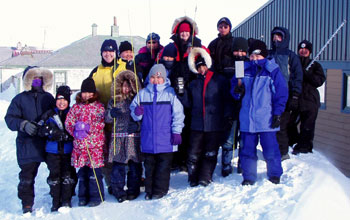Multimedia Gallery
ALISON (Image 2)
ALISON (Image 2)
Elementary school students from Wales Kingikmiut School in the Kingikmiut Village of Wales are participating in the ALISON (Alaska Lake Ice and Snow Observatory Network) program, a science education and scientific research partnership between the University of Alaska, Fairbanks, and the K-12 education community in Alaska. The students set up an observatory at Puvragik Lake ("The Swimming Place"), where they learned how to measure snow depth and temperature and how to take snow samples which they inside and subsequently weighed and their density determined.
Measurements taken at the observatory will be used for numerical modeling to simulate the variability of lake ice growth and decay at the present time and during the period of meteorological record in the different climate zones of Alaska, and to understand the factors responsible for that variability in order to predict the response of the ice to future climate change.
The village of Wales is located on the western tip of the Seward Peninsula on the Bering Strait at 65° 37.436'North, 168° 5.950'West. The Puvragik Lake observatory is the westernmost ALISON site in Alaska. It is located about a quarter mile north of Kingikmiut Village of Wales. Some local residents use the lake to cut ice for fresh water. The lake is shallow along the edges and deep enough in the middle to land a single engine float plane.
This research was supported by National Science Foundation Office of Polar Programs grant OPP 03-26631. (Date of Image: March 2004) [One of 8 related images. See Next Image.]
Credit: Photo by Martin Jeffries, Geophysical Institute, University of Alaska, Fairbanks
Images and other media in the National Science Foundation Multimedia Gallery are available for use in print and electronic material by NSF employees, members of the media, university staff, teachers and the general public. All media in the gallery are intended for personal, educational and nonprofit/non-commercial use only.
Images credited to the National Science Foundation, a federal agency, are in the public domain. The images were created by employees of the United States Government as part of their official duties or prepared by contractors as "works for hire" for NSF. You may freely use NSF-credited images and, at your discretion, credit NSF with a "Courtesy: National Science Foundation" notation.
Additional information about general usage can be found in Conditions.
Also Available:
Download the high-resolution JPG version of the image. (759 KB)
Use your mouse to right-click (Mac users may need to Ctrl-click) the link above and choose the option that will save the file or target to your computer.

